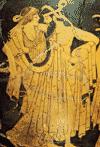- red-figure pottery
-
Developed in Athens с 530 BC, the red-figure pottery quickly overtook the older black-figure pottery as the preferred style of vase painting. In red-figure technique, the background was painted black, and the outline details on the figures were also painted (rather than incised) in black, but the rest of each figure was unpainted and so retained the orange-red colour of the natural vase. By comparison with incising, the painting of the details allowed more flexibility in rendering human form, movements, expressions, and perspective. Since most of the ornamentation was narrative, such technical advantages were of utmost importance.
 Athenian red-figure cup, detail of a bearded reveler by the Brygos Painter, c. 490 BC; in ...J.E. Bulloz
Athenian red-figure cup, detail of a bearded reveler by the Brygos Painter, c. 490 BC; in ...J.E. Bulloz* * *
▪ arttype of Greek pottery that flourished from the late 6th to the late 4th century BC. During this period most of the more important vases were painted in this style or in the earlier, black-figure (black-figure pottery) style. In the latter, figures were painted in glossy black pigment in silhouette on the orange-red surface of the vase; details were added largely by incising. In the red-figure style, decoration was also outlined in black, but the background outside the outline was filled in with black, leaving the figures red. Details were painted rather than incised, thus allowing more flexibility in the rendering of human form, movements, and, above all, expressions and allowing scope for shading and a more satisfactory kind of perspective. Since most of the ornamentation on Greek pottery was narrative rather than purely decorative, such technical advantages were of utmost importance.Red-figure pottery can be roughly divided into two periods: the first from about 530 to 480 BC, the second from about 480 to 323 BC. In the early vases—the subjects of which included heroic and Dionysiac scenes as well as scenes from daily life—the details are added in black pigment or in dilutions of black that appear brown. The artists had mastered foreshortening and could convey the illusion of a third dimension without violating the two-dimensional surface of the vase. The figures were decorative rather than naturalistic. The most important artists from this period are Oltos, Epictetus, Euphronius, Euthymides, Onesimos, Douris, and the Brygos Painter. The vases characteristic of the second period are gaudier, with details added in white and sometimes in yellow-brown, gold, and blue. The subjects and treatment are often trivial and sentimental; and attempts at naturalism and depth perspective violated the intrinsic nature of the pottery shape, reducing the vessel to a mere support for the painting. By the end of this second period, the figured decoration of pottery, having become a declining art, died out in Attica.* * *
Universalium. 2010.
